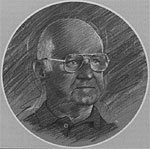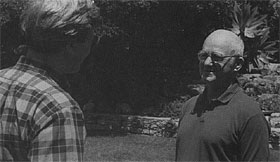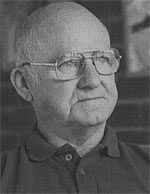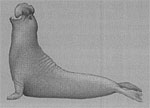Interview: George Bartholomew

George Bartholomew helped to define a new field of biology. Starting his career as a physiologist, he worked with a variety of animals: elephant seals, kangaroo rats, pocket mice, insects, and many others. In his research he frequently found himself making comparisons between animals, observing the different ways in which organisms meet the challenges of their environment and how their limits of tolerance for environmental stresses determine where they can live. Dr. Bartholomew's work brought into focus the young scientific field now referred to as "physiological ecology."
In addition to his research accomplishments, Dr. Bartholomew has a reputation for training an impressive number of outstanding graduate and postgraduate students. During his 40 years on the faculty at the University of California, Los Angeles, scores of students have worked with him in his laboratory. Based on his thorough research and consistently important publications, Dr. Bartholomew has earned membership in the prestigious National Academy of Sciences. By inspiring excellent scientific work in others, he has also earned admiration as the model scientist of nearly all working physiological ecologists today.
In this interview, George Bartholomew discusses his scientific philosophy, the case for the organism-environment interface as the focal point of physiology, and the importance of natural history in modern biology.
You must have had more than the average child's curiosity about animals. How did that interest develop?
When I was a young boy, I spent a lot of time at the Field Museum of Natural History in Chicago, so it probably started there. In any event, by the time I was in junior high school, I knew I was going to be a zoologist. When I was a little older, I thought it would be fascinating to go to distant parts of the world and study strange animals. It wasn't until I was an undergraduate at the University of California at Berkeley that I realized that to spend my life studying animals in the modern world, I would have to get a Ph.D. So I went on to graduate school at Harvard. I got my job here at UCLA directly after I got my Ph.D. degree in 1947 and have been here ever since.
You're a member of the National Academy of Sciences. Can you say a little about the academy and how it selects its members?
The official business of the academy is to advise the government on matters of policy relating to science and technology. It operates through the National Research Council, which appoints committees usually chaired by a member of the National Academy, though nonmembers are on the committees, also. It was founded, in the time of Abraham Lincoln, as an advisory group to the executive branch, but now it works for the government generally. It also is a place where scientific policy is formulated. Sometimes it seems to be primarily a place where people get honors. A lot of energy goes into deciding who's going to get elected. I don't know of any people in the academy who are not first-rate scientists. But there are a very large number of equally good scientists who are not in. It depends on many, many things.

Your work has helped define the field of physiological ecology. What exactly is this field of research?
In zoology, physiological ecology is an examination of those aspects of physiology that relate to the animal as an organism and to its interactions with the environment. So the obvious things would be energetics, nutrition, water economy-where there are exchanges between organism and environment. By extension, this has come to include a good bit of behavior: for instance, migration and the environmental timing of reproduction.
Within that broad field, what are some of the specific problems that have captured your interest?
A long time ago I decided that I would try to study things as basic as possible. The basic things that every animal has to do are expend energy to keep itself going, reproduce, process water, and be a member of a social group. So all of my research, however diverse it may appear, relates to social behavior, energetics, water economy, or reproductive timing. Each of these has its own literature in a separate field, but they're all very closely related. If you are studying organisms, you cannot afford to isolate the standard fields of specialization. The animal doesn't distinguish between its behavior and its physiology, or its ecology and its morphology. It's an integrated system that does all these things. The specialties are a convenience for human beings so they don't have to know so much. In my own case, since I'm first and foremost a naturalist interested in animals, I would rather let the animal tell me what questions to ask.
I've studied many, many different animals, ranging from sea lions to insects. Energetics is my usual point of departure in physiology. For instance, I've studied the energetics of flight in hummingbirds, which meant moving into aeronautics and fluid dynamics and such things. That ties in very closely with pollination by hummingbirds. And as far as plants are concerned, Sphinx moths occupy the same general pollinating role, so the first thing you know, you end up worrying about flight in birds and in insects.
One of the themes of our textbook is the correlation of structure and function. Can you give an example of how this basic integrating principle has been important in your work?
In my own work I really don't distinguish between structure and function. For an animal to do something, he's got to have the machinery to do it with. This machinery is part morphological, part physiological, and part behavioral. Structure and function are not merely close together, they are essentially the same thing.
I'll give you a simple, direct example. When I first decided to do some work on insects, I wanted to do a field project that was physiological and also simple enough that I would have some chance of doing it as a novice insect student. I decided to study the temperature of flying moths in Costa Rica from sea level, which is humid tropics, to the top of the mountains (an altitude of 12,000 feet), where it freezes at night. Bernd Heinrich and I started out capturing all different kinds of moths at different altitudes. As we got to measuring the body temperature, which is a physiological attribute of the animal, we realized very quickly that the ones that were hot had small wings and heavy bodies. The ones that were not so hot had great big wings and small bodies.
So even before we analyzed our data, we found out that body temperature was closely correlated with wing loading, the ratio of wing area to the mass of the animal. This is a morphological attribute. An insect with small wings can't fly unless he's hot because his muscles won't contract fast enough to generate the force for lifting. However, an insect with very big wings that will flap very slowly doesn't have to be warm. His muscles work just fine at a lower temperature. We ended up producing a rather elaborate study of the interplay between morphology and physiology in terms of wing size. So structure and function are inseparable.

You've pointed out that evolution by natural selection adds a dimension to biology that makes this science fundamentally different from physics and chemistry.
I'm convinced that this is so, although I have come to realize that, if you are taking a broad view, physics and chemistry have evolved as the universe has evolved. But when you introduce natural selection into the process—with reproduction, with genetics—it throws into very sharp relief the fact that chance and history determine what organisms do and become and what they are.
In that situation, you really have to measure something and study it very carefully, because the results cannot be predicted from logic. Once you make a measurement, an observation, then you can rationalize it and make it fit logically. But you can't predict it beforehand.
For instance, I would never have predicted, given what I know about vertebrates, that small insects would be endothermic ("warm blooded"). That's because there are no small endothermic vertebrates; all the little ones, really little ones, are ectothermic ("cold blooded"). It never occurred to me, until I began studying insects, that maybe some little ones could produce enough heat to warm up. In fact, it turns out that there are lots of tiny insects that are endothermic when they are active. Once I discovered it by measuring them, a whole new world was opened. How can they be warm-blooded when they are so small? What are the factors that favor it? What mechanisms allow it? What's the machinery? So then you have the morphological, the physiological, and the evolutionary all intertwined.
In the realm of biological research, how would you describe creativity?
A creative scientist has to be a good scientist. The ideas have to be innovative—a new way of looking at the world—and have to lead to general conclusions concerning widespread phenomena. Innovativeness and generality, I would think, are the criteria of very good science. The problem becomes how to be innovative. Luck has a great deal to do with it, of course. My own approach to innovation is to take a nonstandard animal, see what it wants to tell me, and then go measure it. The consequence is that you turn up all kinds of things that are interesting. Some of them are important, some are just fun. Using the animal and its evolutionary history as your guide will, I think, let you do innovative research.
What did you mean when you wrote that expertise is creatively stifling?
Expertise means that at some point in your life you have put boundaries on what you know. You can become an expert on only some little bit of the world. And if you are going to become the world expert on this phenomenon, you are closing your eyes to the diversity of the rest of the world. In that sense, I think it's stifling. If it fits your temperament to become an expert, to look in ever greater detail, and if you have a good mind, you can find out cosmically important things by looking at small issues. It's not that specialization is evil. Every working scientist is a specialist. It's just that if you become an expert in one little thing you don't see where you are.
Can you give a specific example of the kinds of problems that arise from biology having become fragmented into so many subspecialties?
Because the literature is so big, nobody can follow it all, even with computerized support. You really can't. There are whole important traditions of thought that somebody like myself knows nothing of, and I'm a part of a tradition that another kind of biologist will know nothing of. If I were concerned with DNA and cloning, I couldn't possibly master that and also be competent as an ecologically oriented population geneticist. There is an unbroken series of connections from DNA to population biology, yet there are people working at each end who don't even know each other's vocabulary.

You've advocated an enlarged role for natural history in modern biology. How do you define natural history? What are its main questions and how can natural history improve physiological research?
The traditional questions of natural history have been: What organism is it? Where does it live? How does it live? How did it get to do things the way it does? If you dress these questions up into scientific language, the questions become: What is the systematic status of this animal, its evolutionary history, its functional physiology and morphology, and its ecology? All of these fields I've just mentioned are subsets of natural history. The subset means that you're looking at only part of the animal's function. In this sea of information we are all swimming in, if we keep going back to the natural history of the organism, we are offered an integrated theme to make our limited findings meaningful.
You've argued that traditional physiological approaches that sometimes ignore considerations of natural history have mistreated some important topics. Can you give an example?
The one that's nearest and dearest to my heart is hibernation, which I have studied at intervals all of my professional career. The most striking thing about hibernation is that mammals cool off, they reset their thermostat. Thus, hibernation is often considered to be a special case of thermoregulation, and most students of mammals have studied hibernation as a way to look at mammalian thermoregulation. That's because they are used to thinking in terms of thermoregulation as a discipline. In fact, hibernation is one of many devices for scheduling energy expenditure. If you look at it that way, hibernation then becomes a special case of all other sorts of energy schedulings, from circadian rhythms to seasonal cycles, to fat deposition, to sleep. And it involves not just mammals, but all animals that schedule energy transactions. The traditional study of hibernation has blinded people who came into it from biochemistry or neurophysiology to what they were really studying.
You were mentioning earlier that you advise students not to become overspecialized too early in their career. But you've also suggested that young scientists should develop an effective scientific orientation early in their careers. What do you mean by that?
Specializing too early is like making any decision early in life that will affect your later life: You're closing many doors. You should keep the doors open as long as possible. By effective scientific orientation, I mean that that even though you avoid overspecialization, you do not avoid the rigor that goes with trying to be a sound scientist. In contemporary terms this means that you have the necessary physical, chemical, and statistical background in addition to your biology that will let you go in any one of a number of directions depending on where a research problem goes.
If you look over the history of science, aside from perhaps a few towering figures who can do it by brute power, most of us do it by serendipity. We work hard and long on some things and some things fall in our lap. And unless you have an open mind and sufficient breadth in your approach to exploit the things that fall in your lap, you miss them.
I have made an issue of this in my own career. It is very important to do your own science, not to be a science administrator, and to be open to whatever happens. This hands-on approach means that when something interesting comes up, you see it and can change your problem, redesign your experiment, instantly. But if your data are gathered by technicians and something unusual comes up, the chances are you won't even know about it.
I'll give you an example from my own experience. When I first came to UCLA, I thought I would study desert birds, but I was interested in mammals as well. I caught some little pocket mice and brought them into the lab, mostly just because they were cute and easy to take care of. I had them right in front of me above my desk where I would see them every day. When I came in, in the mornings, I noticed they looked pretty sluggish. I thought, they must need water or something. When I took their temperature, it turned out to be 20° (instead of 37°, which is what all self-respecting mammals are supposed to be). It turned out that this was quite commonplace. These animals turned off; they would drop their body temperature. In this way, I stumbled onto heterothermic mammals, and I think that I was the first one who documented it as a routine phenomenon in this family (Heteromyidae) of mammals. It happened because I was watching the animals. If I had had a technician go in and stir them up in the morning and feed them and so on, I would never have seen them except in their active state, would never have stumbled on an interesting problem.
I think most of the fun in science is the unusual and unexpected. If you knew what was going to happen with such precision that you could successfully predict it, you wouldn't have to make any measurements. And if you are just a research administrator, no matter how clever you are, and how much money you get, and how many assistants you have, you are missing a lot of the fun. You're also missing a chance to find some new things. You may find what you're looking for, but you won't find the related things that may be even more important.
You view science as a social enterprise. Can you explain what you mean by this?
The ideas of science are not things that come out of one's head. Scientific thought is a historical phenomenon and it's an extended phenomenon spatially. A scientist cannot operate in a vacuum. He can operate only in association with other scientists and as a part of the stream of time. Each of us stands, of course, on the shoulders of the generation who went before. Science is a part of human culture and, to be effective in it, you have to participate, at least to the extent of taking advantage of other people's ideas, insights, methods, and machinery.
You have a remarkable history of training graduate students who go on to productive and distinguished careers. Do you have some ideas about what makes you such an effective mentor?
The main thing is to get good students. I have been very, very choosy. Each of the graduate students I accepted became an important person to me and I gave them all loving attention. I worked in the lab continuously, so I was with them every day. Anything I knew, they soon knew. When it came to writing the dissertation, they wrote the first draft and I would tear it to bits, absolutely tear it to bits, because I felt the most important thing I could do was to make sure that they were good scientific writers by the time they finished. I never published or put my name on a dissertation that was a student's own. So I gave them the immediate rewards. The combination of hands-on attention and aggressive editing of the dissertation is the only thing I can think of, really, aside from getting good students.
With each student I've entered into a contract: After a year I will tell you whether I will accept you permanently. The first year is provisional. If you don't like me, if you and I don't strike it off, if I don't think you have it, or if your approach is inappropriate for my style, I will do my best to get you another advisor or another niche someplace, either here at UCLA or at another school.
One other thing that was terribly important was a weekly meeting to which my graduate students came. It was a continuing seminar that ran year after year. The students participated in it from the beginning to the end of their graduate studies, so that there were always beginning graduate students and advanced graduate students and a couple of postdocs with me in the seminar. And we all worked together. We would report on our research. We'd read books and articles together and discuss them. This kept me alive and up-to-date, because I was drawing on the library resources of eight or ten people, continuously. This let me communicate to them everything I knew about science, and it let the senior grad students teach the junior ones, and let the postdocs put in different points of view that came from other institutions.
You've described creativity as a form of youthful play. How can we keep playing as we get older? How can middle-aged and older professors benefit from their students?
Associate with them. I started saying, when I was about 45, that I'm intellectually dead without my students. I know I would have bogged down into teaching the same stuff year after year and doing the same kind of research. But with students you can't. You know, they're all different. They all want to do different things. Related to that, I always let the students choose their own problems. I never assign problems, which means that you have people working on all kinds of things in the lab. And that's one way you retain your youthful point of view. I think the student is the center of the research enterprise.
©2005 Pearson Education, Inc., publishing as Benjamin Cummings